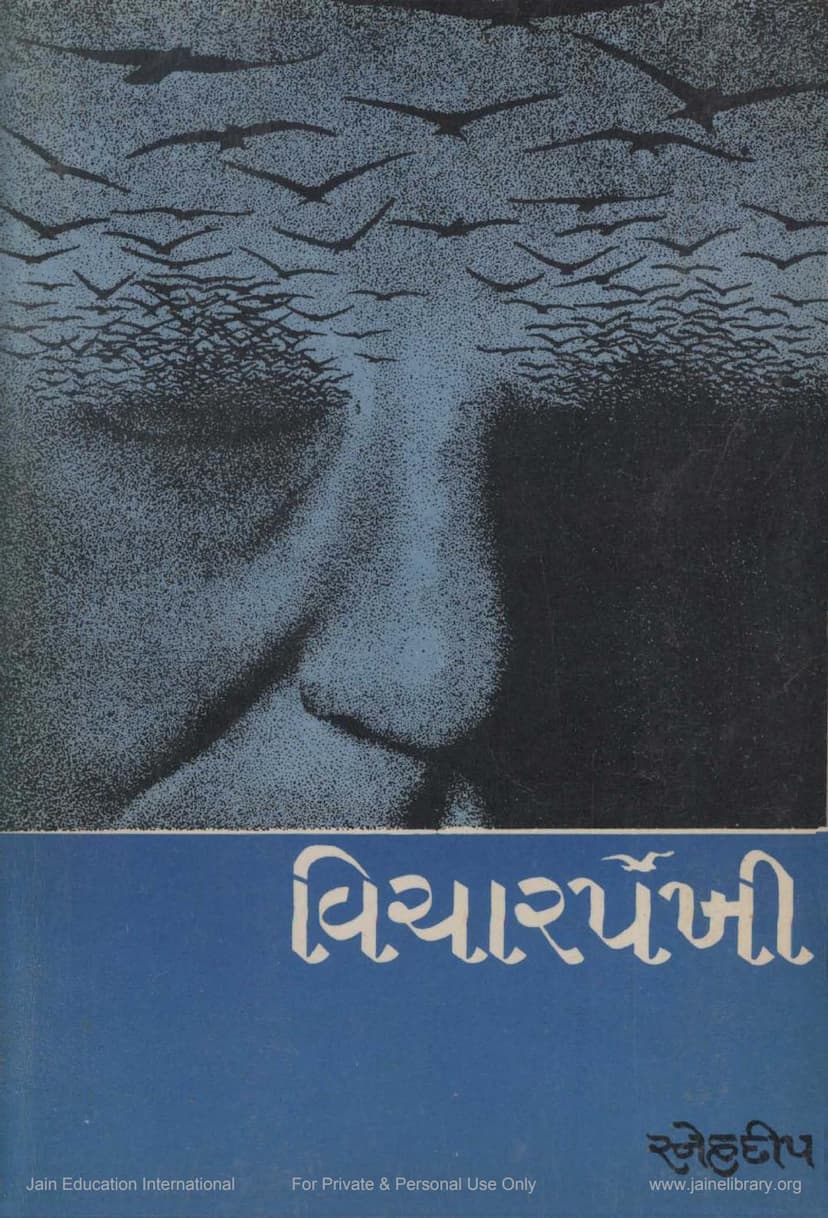Vicharpankhi
Added to library: September 2, 2025

Summary
This is a comprehensive summary of the Jain text "Vicharpankhi" by Snehdip, published by Vishvakalyan Prakashan Trust, Mehsana. The book is a collection of inspiring thoughts and reflections on various aspects of life, presented in a philosophical and spiritual manner, with a strong emphasis on Jain principles and teachings.
Here's a breakdown of the key themes and messages found throughout the text:
Core Philosophy and Life's Purpose:
- Life's True Purpose: The book repeatedly emphasizes that life is not merely for eating, sleeping, or struggling through. It's for self-discovery, awakening the soul, and transforming oneself from an ordinary being into a divine one ("Narmathi Narayan," "Janmethi Jain," "Jainmethi Jin," "Jivmathi Shiv").
- Living with Purpose: Life is presented as an opportunity to fill the darkness with light, to live with vitality and enthusiasm, and to achieve spiritual enlightenment.
- The Inner Journey: The longest journey is the "journey inward." The book encourages introspection and self-understanding as the foundation for all meaningful experiences.
- Accepting and Embracing Life: Life is a multifaceted experience, a "gift," a "song," a "journey," an "opportunity," a "struggle," an "adventure," a "puzzle," a "spirit," a "bliss," a "goal," "beauty," a "drama," a "dream," a "book," "love," a "game," "chess," a "temple," and a "challenge." The key is to accept, overcome, perform, face, unfold, sing, complete, take, fight, dare, solve, realize, feel, achieve, praise, act, read, enjoy, play, win, decorate, meet, dive into, eat, and celebrate it.
Personal Growth and Self-Improvement:
- Action and Productivity: The importance of staying "busy" and doing something "good" is highlighted. Idleness leads to stagnation, while activity and creativity bring life and purpose.
- Resilience and Perseverance: Falling is not failure; remaining fallen is. The text encourages picking oneself up after setbacks, learning from mistakes, and trying again.
- Self-Reliance and Inner Strength: True strength comes from within. Relying on oneself and cultivating courage are vital for overcoming challenges.
- Mindfulness and Present Moment Living: The past and future are fleeting. True existence lies in the present moment. Living in the present with awareness is the key to happiness.
- Controlling Emotions and Thoughts: The book advises against being controlled by external events or others' opinions. Self-control over anger, desires, and negative thoughts is crucial.
- Forgiveness and Letting Go: Holding onto grudges and past hurts is detrimental. Learning to forget and forgive is essential for inner peace.
- Simplicity and Detachment: Avoiding excessive expectations, desires, and attachments leads to contentment and happiness.
Relationships and Social Harmony:
- The Power of Friendship: The book emphasizes the value of friendship and cultivating a strong circle of friends, highlighting that true friendship requires empathy and sacrificing ego.
- Compassion and Empathy: Understanding and feeling the pain of others is a noble quality. True compassion brings inner peace and makes one truly human.
- Communication and Speech: Speaking with kindness, truthfulness, and thoughtfulness is an art. Brevity and sweetness in speech are valued.
- Respect and Understanding: Treating others with respect, avoiding prejudice, and understanding different perspectives are crucial for harmonious relationships.
- Family Bonds: The importance of maintaining strong family relationships, particularly between mother-in-law and daughter-in-law, is discussed, advocating for love and mutual respect over conflict.
Spiritual and Jain Principles:
- The Role of Aspirations and Expectations: Uncontrolled aspirations and expectations are seen as the root of suffering. Moderating them is key to happiness.
- The Power of "Ahimsa" (Non-violence): This extends beyond physical harm to include not hurting others emotionally or mentally.
- The Significance of Festivals: Festivals like Navratri, Raksha Bandhan, Diwali, and Paryushan are presented not just as celebrations but as opportunities for spiritual reflection, self-improvement, and strengthening virtuous qualities.
- The Importance of "Samyama" (Self-Control): The book stresses the need for self-control in all aspects of life – eating, speaking, behavior, and thoughts.
- The Power of "Tapa" (Austerity) and "Japa" (Chanting): These practices are highlighted for their role in purifying the soul and achieving spiritual growth.
- The "Navpad" Aradhana: The text dedicates significant portions to the worship and contemplation of the nine supreme beings in Jainism (Arihant, Siddha, Acharya, Upadhyaya, Sadhu, Samyag Darshan, Samyag Gyan, Samyag Charitra, and Tap), explaining their significance and the practices associated with their worship.
- The Significance of "Kushala" (Skillful Living): The book advocates for living life with skill, understanding the true meaning of joy and sorrow, and finding solutions to problems.
- The Concept of "Anekantavada" (Multiplicity of Viewpoints): While not explicitly named, the spirit of understanding different perspectives and avoiding rigid judgments is woven throughout the text.
Figurative Language and Metaphors:
The book uses numerous metaphors and similes to convey its messages, such as:
- "Vicharpankhi" (Thought Bird): The title itself suggests the free-flying nature of thoughts and ideas.
- "Diwali" as the inner lamp of self-awareness.
- "Life as a river" or "fountain."
- "Expectations as a jungle."
- "Fear as termites."
- "Words as arrows."
- "Life as a chess game" or "cricket match."
- "The mind as a temple."
Overall Tone and Message:
The book is motivational, philosophical, and spiritual. It encourages readers to live a meaningful life, to strive for self-improvement, to cultivate positive relationships, and to seek spiritual liberation. The language is often poetic and evocative, making the profound concepts accessible and inspiring. The author, Snehdip, through these reflections, aims to guide the reader towards a more conscious, purposeful, and virtuous existence, grounded in Jain ethical and spiritual principles.